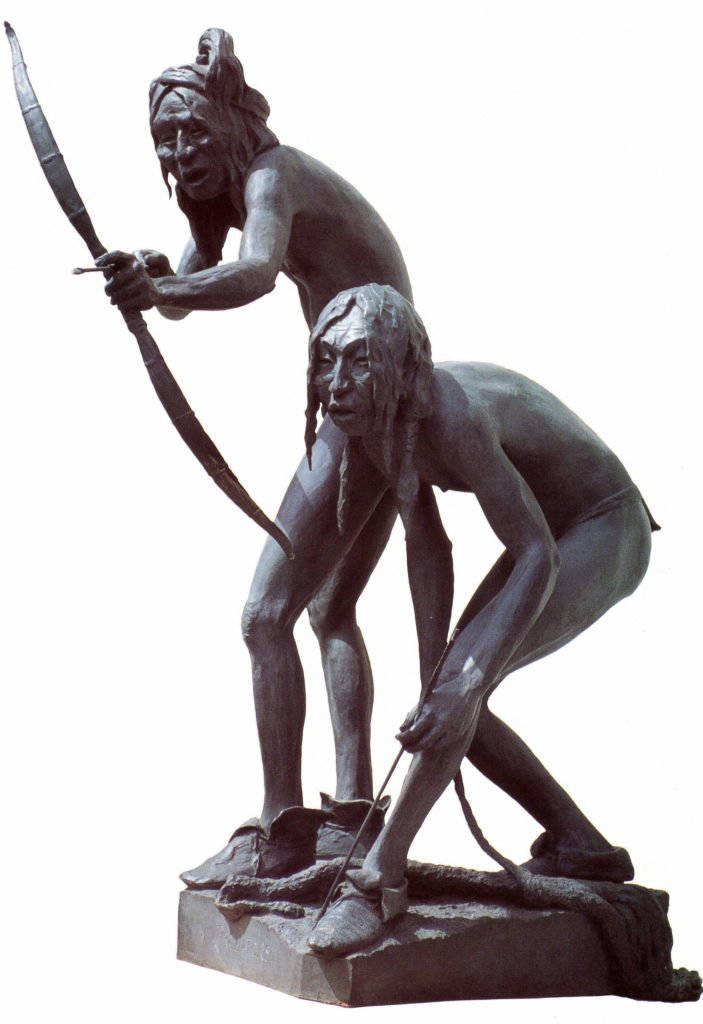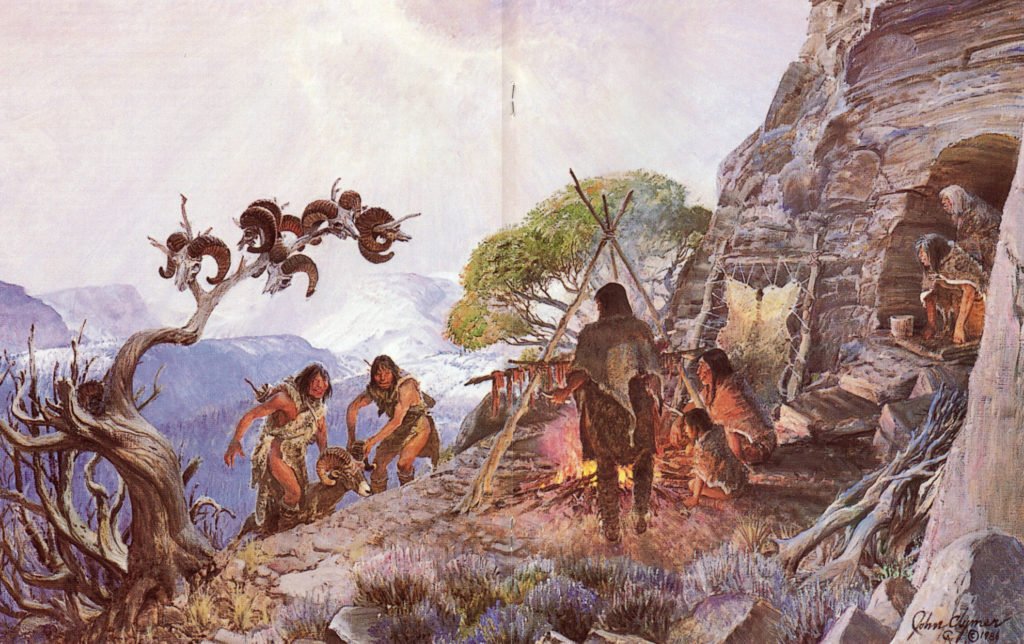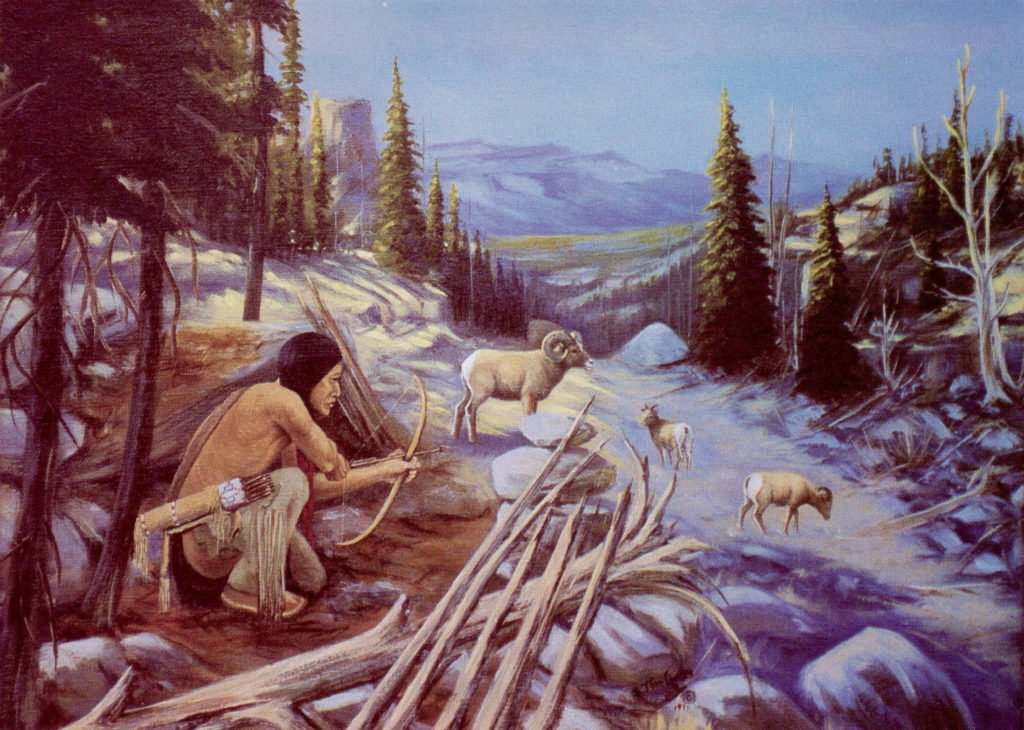February 25, 2022
This story was originally published by St. Stephens Indian Mission Foundation in VOL. XXI APR/MAY/JUNE 1991 NO. 2. St. Stephens Indian Mission Foundation owns the copyright, and the story is reprinted here with permission from the Foundation. More information on the Foundation can be found following the story or by clicking on the link above.
It is unknown when archery was first utilized in America. Archaeological digs have not produced evidence as to which culture was the earliest inhabitant of this region to use bows. One theory speculates that archery had not been discovered when the first immigrants migrated across the land bridge of the Bering Strait. Massive glaciers covered this area and as ice moved in, shutting off the corridor of return, these ancient people moved further south into warmer climates. Evidence indicates that these people were diggers and gatherers, procuring their food from edible roots and wild plants.

Centuries later, when the ice receded, other people began migrating from Asia to this region. They traveled along the corridors between glaciers and, it is theorized, one of these later migrations brought hunting weapons to America.
There is a level in archaeological sites at which stone points are found. The most primitive projectiles these digs uncovered were probably used on spears. At a later point in time projectiles were used on the atlatl, a spear throwing device, and then most recently on arrows. Stone points found in New Mexico have been dated by scientists as the oldest projectiles discovered in this region. The Sandia points, excavated from a cave near Albuquerque, could date back as far as 20,000 years ago. The Clovis and Folsom points, also found in New Mexico, were probably used between 9,000 and 11,000 years ago. In any case it has not been determined if the earliest people in this region developed the use of the bow, or if it was brought here by later immigrants. There is proof, however, that once archery was cultivated, it was used from the top of North America to the tip of South America.
As mankind advanced their skills and achievements during the centuries, the world in which they lived also went through some major changes. The huge prehistoric animals disappeared and the smaller species that we know today evolved. The hunting methods of these primitive people changed as did the environment in which they lived. The spear and bow were found to be more efficient in taking deer and elk than they had been in slaying dinosaurs.
Archery was used in different degrees by various cultures. There is verification that the bow was first used more as a means to procure food than as a weapon of defense. Survival was of greater importance than war, as the land was vast and groups of people were widely scattered. The tribes considered it a greater honor to touch an enemy than to shoot him; a practice that held true into the nineteenth century. Various tribes developed different means of procuring their food supply, such as agriculture and fishing, and did not use the bow to the same extent as tribes who continued to be game hunters.

Many woods were utilized in bow making by the various tribes that inhabited this region. In areas where the best woods were found, such as Osage orange, a small thorny tree with hard yellow wood, tribesmen built and put to practical use beautiful wood bows. In the locality of St Stephens Mission woods such as chokecherry, cedar and willows are good bow material. But the Mountain Shoshones, who lived in the higher terrain, were known for their unique skill in making horn bows. One can only speculate why they used horns. Either there was a time in which choice woods were not available, or the intention of the inventor was to build a better bow.
As hunting tribes developed their craft of bow making they also perfected their skills in hunting. They moved yearly with the migrating game; these moves would vary with seasonal conditions but basically the tribes remained in a limited area. Hunters learned the habits and routes of the various species they depended upon for their sustenance. Their skill in stalking was as important as their accuracy in shooting. As their ability as huntsmen and archers improved, the hunters, in turn, provided a better life for their families and tribes.
Boys of each tribe developed archery skills at an early age. Many of their games involved the use of bow and arrows and their hunting lessons began with small game such as rabbits. By the time they were old enough to accompany their fathers and older tribal members on hunts, these adolescents were experienced marksmen.
These early hunting tribes were self-sufficient and trade between the more isolated tribes was infrequent. As in any culture, there were people with specialized skills in making tools and clothing. Therefore, individual members among each tribe were skillful in the craft of bow making. This is not to say that each hunter could not repair or make a wood bow or new arrows and points if the need arose.

The necessities of different cultures have changed the design of archery equipment since its origin. None caused as much change for the inhabitants of this area as the introduction of the horse. A hunter on foot was not concerned so much with the length of the bow but with its performance. As the Buffalo Culture of the Plains Indians evolved, the hunter eventually sat on the back of a horse. A rider’s means of controlling the animal was a leather thong through the mouth of the horse to which reins were attached. But it takes both hands to shoot a bow; for that reason, commands were relayed to the horse by a rider’s legs during a pursuit. The design of the bow of the Plains Indians had to be short, as it was essential that the mounted hunter be able to shoot from either side of the horse. Buffalo, the largest game animal in this region, have thick hides and heavy bodies. A powerful bow must be used for arrows to penetrate the body. Plains Indians shot arrows at very close range while giving chase to stampeding herds in their quest for buffalo. Even when these hunters were not on horseback their skill in stalking game brought them within close range of their prey. Therefore, the interval of distance was not the main factor of design in bow making for Plains Indians.
Weapons had changed drastically before Europeans sailed their ships to the Americas. The bow and arrow was replaced with the production of firearms. But many explorers in the new world soon realized that a black powder rifle was no match for the bow and arrow. An experienced archer could shoot, with deadly accuracy, a half dozen arrows to every shot from a muzzleloading rifle. Firearms were more of a curiosity for early Indians to possess, rather than a functional weapon. Without a source of powder, lead and replacement parts, a rifle was of no use in the remote lifestyle of the Indians.
When the earliest trappers arrived in the Rocky Mountains they were armed with small caliber, long rifles. The trappers like the Indians, learned they needed a more powerful weapon to harvest big game, and if it was to be used on horseback, it must be short. The Hawkins family of Saint Louis, Missouri designed and built a shorter, heavier caliber, muzzleloading rifle. However, the bow was not outmatched until the the repeating rifle was introduced and the advantage went to the rifleman.

St. Stephens Indian Mission Foundation is a non-profit organization, incorporated under the laws of the State of Wyoming on March 31, 1974, and listed on page 184 of the 1993 OFFICIAL CATHOLIC DIRECTORY. The sole purpose of the foundation is “to extend financial support to St. Stephens Indian Mission and its various religious, charitable and educational programs and other services conducted primarily for the benefit of the Northern Arapaho and Eastern Shoshone Tribes on the Wind River Indian Reservation.”
Posted in Notes From the Field